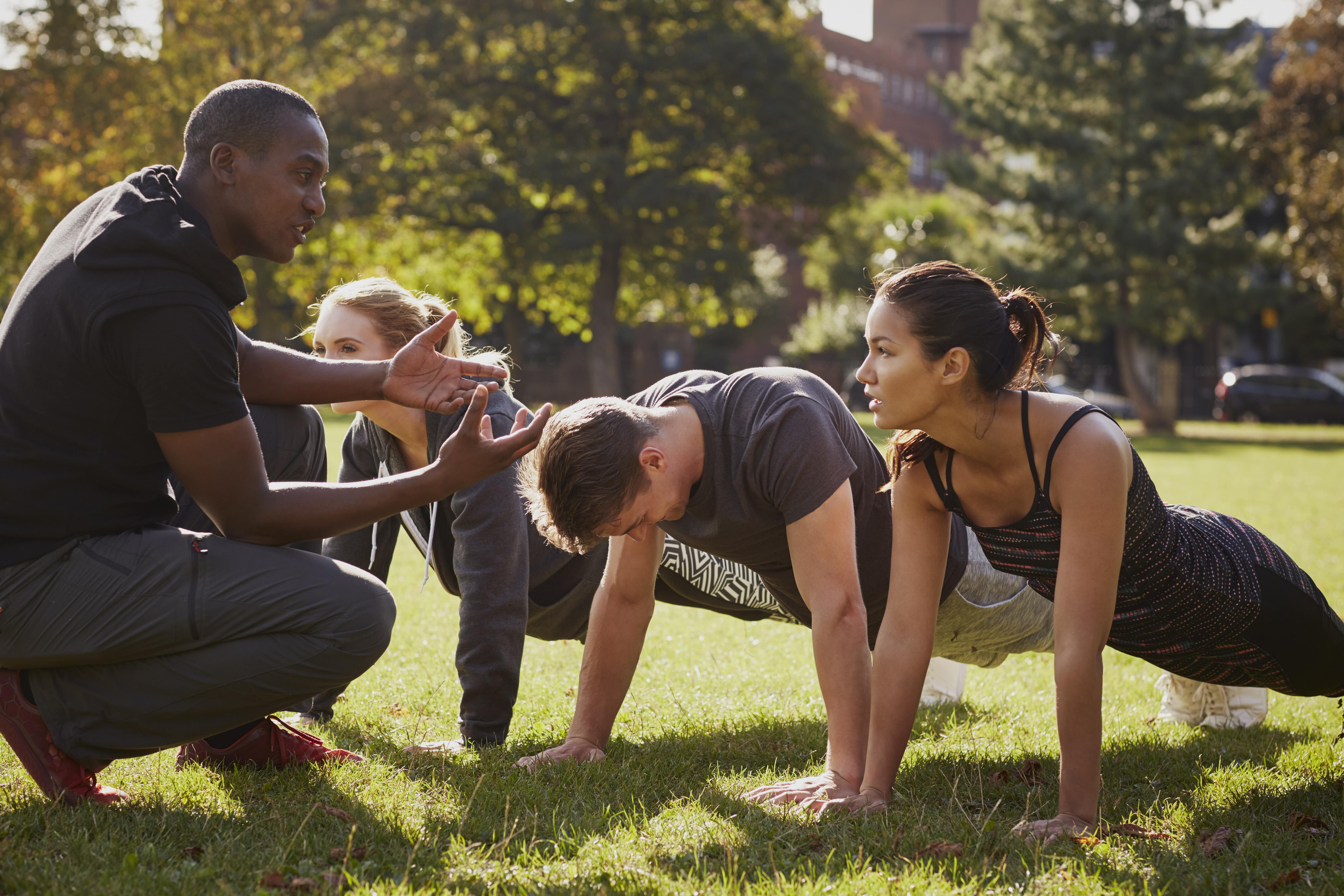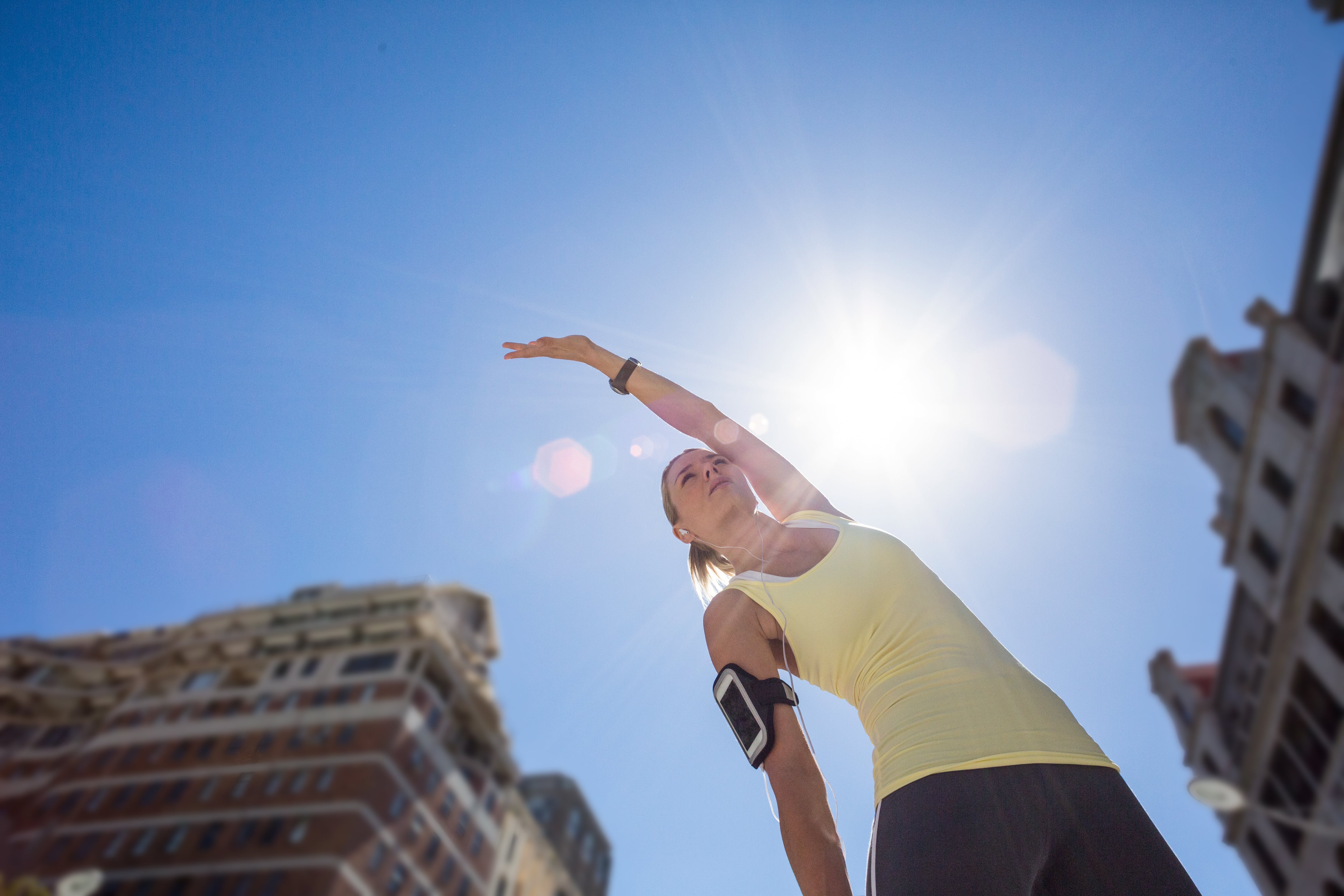Key Takeaways
- Heat training involves intentionally exposing the body to high temperatures (greater than 86 degrees Fahrenheit) through various methods, such as exercising in hot environments outdoors, using saunas, or following structured heat-acclimation routines.
- Exposure to heat, either passively or during workouts, has been shown to have positive effects on metabolism and glucose control by increasing energy expenditure, enhancing insulin sensitivity, and improving fat oxidation.
- The safe and effective incorporation of heat training requires gradual adaptation, proper hydration, and awareness of individual responses, especially for individuals with underlying health conditions.
{{mid-cta}}
It’s summertime, so naturally, we are exposing ourselves to exercise in the heat, whether we want to or not. However, the concept of “heat training” goes beyond the obvious, as many athletes and fitness enthusiasts seek out hot environments to amplify their fitness goals. From infrared saunas to hot yoga, this trend has enticed various disciplines with claims of significantly affecting the metabolic system.1 Athletes have long been using heat exposure as a tool for acclimation and recovery; however, the rest of the population is adopting the technique to boost their metabolic function, overall wellness, and personal fitness goals.
Regarding metabolic health, heat training has the potential to positively affect insulin sensitivity, glucose regulation, fat oxidation, and cardiovascular efficiency in the long term; however, this remains unclear in the short term.2,3,4 Whether through passive heat exposure (like sauna use) or active workouts in the heat, we know that elevating core body temperature triggers physiological responses similarly to the effects of high-intensity exercise or resistance training.3,5
As science continues to explore the connections between heat exposure and metabolism, heat training may emerge as a valuable tool for enhancing health outcomes and athletic performance, benefiting individuals at all fitness levels who aim to achieve optimal health and wellness. Let’s turn up the heat and dive into the details.
What Is Heat Training?

Heat training involves intentionally exposing the body to high temperatures (hotter than 86 degrees Fahrenheit) through various methods, such as exercising in hot environments outdoors, using saunas, or following structured heat-acclimation routines.6 These practices elevate the body’s core temperature, which in turn activates a cascade of stress responses aimed at maintaining equilibrium, such as increased sweat rate, improved blood plasma volume, and enhanced cardiovascular function. You also tend to see increased activity of heat shock proteins, which are molecules that help protect cells and support recovery.7 In fact, research studies show heightened heat shock protein activity may improve metabolic health in adults who struggle with obesity and type II diabetes.8,9
Overall, scientific articles may not agree that one session in the sauna creates any acute positive effect on glucose or insulin levels; moreover, repeated exposure to heat over time may improve the body’s efficiency in cooling itself, while also triggering a plethora of metabolic adaptations.1,4
The Metabolic Effects of Heat Training
Let’s take a moment to discuss how heat exposure specifically creates all of the positive effects on cardiovascular and metabolic systems. For one, you tend to see an increase in energy expenditure both during and after heat exposure due to the extra effort required to maintain a safe core temperature. The body works harder to cool itself through elevated heart rate, increased sweat production, and enhanced circulation, all of which raise calorie burn even if you aren’t exercising at the time.10 At the cellular level, heat exposure activates those heat shock proteins, which work like an army of defense to keep your cells working properly when under stress. They play a protective role in reducing inflammation, stabilizing damaged proteins, and improving the function of the insulin receptors.11,12
Additionally, regular exposure to hot environments may enhance mitochondrial efficiency.13 Mitochondria are cellular organelles that assist in breaking down fat and glucose for energy; thus, improving their function can lead to better fuel utilization and metabolic flexibility (the ability to switch between fats and carbohydrates for energy) in the long term. This also improves insulin sensitivity, as efficient mitochondria and decreased inflammation are both linked to better glucose uptake and regulation.13
When you combine an increase in energy expenditure, lower inflammation, and improved mitochondrial efficiency, it becomes clear that incorporating heat training into our wellness routine can be a valuable tool for enhancing metabolic health in both athletes and the general population.
How Heat Affects Glucose Regulation

Those with metabolic disorders, especially type II diabetes, PCOS, or insulin resistance, may choose to engage in heat training regimens purely for the blood sugar control effects. When your body heats up, blood flow increases, and muscles begin to absorb glucose from the bloodstream to meet the energy demands of thermoregulation. There may also be a short-term increase in insulin sensitivity, making it easier for your body to manage blood sugar efficiently after heat exposure.14
However, the conflict in scientific studies stems from the potential effect of heat on the release of stress hormones, such as cortisol and adrenaline. While this is a normal response of our “fight or flight” mechanism, excessive or prolonged cortisol and adrenaline from heat training can elevate blood sugar levels both acutely and in the long term.
As a result, individual glucose responses to heat can vary significantly based on factors such as the duration and intensity of exposure, time of day, hydration levels, and other comorbidities. For some, heat can temporarily lower glucose levels, while those under high stress or with insulin resistance may experience short-term spikes and insulin instability.2,15
Heat Training vs. Traditional Exercise
Imagine doing burpees in a room heated to 95 degrees, without any fans to help you cool down. You’d likely get tired much quicker, right? Heat training adds an extra metabolic load compared to regular training because it requires regulating your body temperature while performing the same physical activity. Your heart rate increases, calorie burn soars, and more demand is placed on the cardiovascular and muscular systems. Research has shown that this combination may further accelerate fat metabolism, improve endurance, and enhance glucose control more effectively than standard training alone, even in competitive athletes.16
For individuals who have hit a fitness or fat-loss plateau, incorporating heat can provide a simple stimulus that promotes further adaptations.17 That said, heat training should be used strategically and with a gradual approach that also prioritizes hydration, rest, and slow progressions to avoid overloading your body and prevent some of the risks associated with exercise in hotter environments.
Safety Considerations and Risks

While heat training can offer significant metabolic and performance benefits, it also comes with certain risks that anyone, even the most elite athletes, should be mindful of. The added strain on the body requires a longer recovery time to avoid hormonal imbalances, excessive fatigue, and even performance setbacks if not managed properly.18
Here are some of the key risks to consider when incorporating heat training into your health and fitness program:
- Dehydration: Heat exposure increases sweat production, which can lead to significant loss of fluid and electrolytes (i.e., sodium, potassium, and magnesium). This can impair performance, cause dizziness and fatigue, and lead to serious health issues affecting heart and nerve function.
- Heat Exhaustion or Heat Stroke: Prolonged exposure to intense heat without adequate rest or cooling strategies can overwhelm the body’s ability to regulate its core temperature, leading to symptoms such as nausea, confusion, a rapid heartbeat, and, in more severe cases, life-threatening heat stroke.
- Injury or Illness: Jumping into heated workouts without building tolerance increases the risk of exertional heat illnesses or injuries. Starting with shorter, less intense sessions and gradually increasing heat exposure over a period of two weeks will help your body acclimate safely.19
- Medical Conditions: Individuals with heart conditions, high blood pressure, glucose or insulin instability, or heat sensitivity should consult their healthcare provider before starting heat training, as it may pose additional risks for these populations.
How to Incorporate Heat Training for Glucose and Metabolic Benefits

To safely and effectively incorporate heat training for metabolic benefits, it’s important to introduce it gradually, understanding that true acclimation can take up to 14 days for adults.19
Explore the following tips to begin incorporating heat training into your fitness routine today.
- Start with short sessions: Begin with 5 to 15 minutes in a warm environment (approximately 86-95 degrees Fahrenheit), such as a heated room or sauna, immediately after a workout. This helps your body adapt to heat stress passively while enhancing recovery and extending the metabolic benefits of your workout.
- Stay hydrated with electrolytes: Replenish fluids and electrolytes before and after heat exposure to prevent dehydration and support energy levels, especially during longer or more intense workout sessions.
- Track your glucose response: If you wear a continuous glucose monitor (CGM), monitor how heat affects your blood sugar levels both during and after. This can help you better understand your body’s unique response as you adjust as needed.
- Pair with nutrient timing: If you're prone to glucose spikes, consider doing heat training in a fasted state or with lower carbohydrate intake beforehand to help moderate blood sugar levels during and after the session.20
The Bottom Line
Heat training has the potential to improve metabolic health, blood sugar control, and support fat metabolism when incorporated safely into a health and fitness routine. Remember to introduce the stress of heat gradually at first, starting with passive exposure via saunas and progressing to actual workout sessions in heated environments. Start small, stay consistent, and listen to your body, as heat can do more than make you sweat; it can help you thrive metabolically.
Learn More About Signos’ Expert Advice
If you have further questions about improving your health, fitness, and nutrition, consider seeking expert advice from the Signos team. A continuous glucose monitor (CGM) can give you the insights to make smarter nutrition and exercise choices. The Signos app offers a personalized program designed to help you achieve your health goals.
Topics discussed in this article:
References
- Pallubinsky, H., Phielix, E., Dautzenberg, B., Schaart, G., Connell, N. J., de Wit‐Verheggen, V., ... & van Marken Lichtenbelt, W. D. (2020). Passive exposure to heat improves glucose metabolism in overweight humans. Acta physiologica, 229(4), e13488.
- James, T. J., Corbett, J., Cummings, M., Allard, S., Young, J. S., Towse, J., ... & Shepherd, A. I. (2021). Timing of acute passive heating on glucose tolerance and blood pressure in people with type 2 diabetes: A randomized, balanced crossover, control trial. Journal of Applied Physiology, 130(4), 1093-1105.
- Bock, P. M., Kowalewski, L. S., Ayres, L. R., Russo, M. K. B., Leites, G. T., Martins, A. F., ... & Krause, M. (2025). Effect of heat therapy compared with strength training on metabolic profile, heat shock response, inflammation, cardiovascular responses and microbiota in individuals with type 2 diabetes: study protocol of a randomized trial. Sao Paulo Medical Journal, 143(3), e2024040.
- Kimball, A. L., McCue, P. M., Petrie, M. A., & Shields, R. K. (2018). Whole body heat exposure modulates acute glucose metabolism. International Journal of Hyperthermia, 35(1), 644-651.
- Roxburgh, B. H., Campbell, H. A., Cotter, J. D., Reymann, U., Williams, M. J., Gwynne‐Jones, D., & Thomas, K. N. (2023). Acute and adaptive cardiovascular and metabolic effects of passive heat therapy or high‐intensity interval training in patients with severe lower‐limb osteoarthritis. Physiological Reports, 11(11), e15699.
- Daanen, H. A., Racinais, S., & Périard, J. D. (2018). Heat acclimation decay and re-induction: a systematic review and meta-analysis. Sports Medicine, 48, 409-430.
- Sawka, M. N., Wenger, C. B., Young, A. J., & Pandolf, K. B. (1993). Physiological responses to exercise in the heat. Nutritional needs in hot environments: applications for military personnel in field operations, 55.
- Henstridge, D. C., Whitham, M., & Febbraio, M. A. (2014). Chaperoning to the metabolic party: the emerging therapeutic role of heat-shock proteins in obesity and type 2 diabetes. Molecular metabolism, 3(8), 781-793.
- Faulkner, S. H., Jackson, S., Fatania, G., & Leicht, C. A. (2017). The effect of passive heating on heat shock protein 70 and interleukin-6: a possible treatment tool for metabolic diseases?. Temperature, 4(3), 292-304.
- Febbraio, M. A. (2001). Alterations in energy metabolism during exercise and heat stress. Sports medicine, 31, 47-59.
- Hu, C., Yang, J., Qi, Z., Wu, H., Wang, B., Zou, F., Mei, H., Liu, J., Wang, W., & Liu, Q. (2022). Heat shock proteins: Biological functions, pathological roles, and therapeutic opportunities. MedComm, 3(3), e161. https://doi.org/10.1002/mco2.161
- Geiger, P. C., & Gupte, A. A. (2011). Heat shock proteins are important mediators of skeletal muscle insulin sensitivity. Exercise and sport sciences reviews, 39(1), 34-42.
- Marchant, E. D., Nelson, W. B., Hyldahl, R. D., Gifford, J. R., & Hancock, C. R. (2023). Passive heat stress induces mitochondrial adaptations in skeletal muscle. International Journal of Hyperthermia, 40(1), 2205066.
- Ely, B. R., Clayton, Z. S., McCurdy, C. E., Pfeiffer, J., Needham, K. W., Comrada, L. N., & Minson, C. T. (2019). Heat therapy improves glucose tolerance and adipose tissue insulin signaling in polycystic ovary syndrome. American Journal of Physiology-Endocrinology and Metabolism, 317(1), E172-E182.
- Westphal, S. A., Childs, R. D., Seifert, K. M., Boyle, M. E., Fowke, M., Iñiguez, P., & Cook, C. B. (2010). Managing diabetes in the heat: potential issues and concerns. Endocrine Practice, 16(3), 506-511.
- Geng, Z., Wu, X., Wang, J., Cao, G., Tan, C., Li, L., & Qiu, J. (2025). Effects of Heat and Hypoxia Training on the Fat Oxidation Capacity of Competitive Athletes. European Journal of Sport Science, 25(6), e12312.
- Souza-Silva, A. A., Moreira, E., de Melo-Marins, D., Schöler, C. M., de Bittencourt Jr, P. I. H., & Laitano, O. (2016). High intensity interval training in the heat enhances exercise-induced lipid peroxidation, but prevents protein oxidation in physically active men. Temperature, 3(1), 167-175.
- Vesic, Z., Jakovljevic, V., Nikolic Turnic, T., Vukasinovic-Vesic, M., Bolevich, S., & Radakovic, S. (2021). The influence of acclimatization on stress hormone concentration in serum during heat stress. Molecular and Cellular Biochemistry, 476(9), 3229-3239.
- Griffin, L., & Maxwell, T. (2024). A Review of Exertional Heal Illnesses (EHI). Sports Medicine.
- Naito, T., Saito, T., Morito, A., Yamada, S., Shimomasuda, M., & Nakamura, M. (2022). Pre-cooling with ingesting a high-carbohydrate ice slurry on thermoregulatory responses and subcutaneous interstitial fluid glucose during heat exposure. Journal of Physiological Anthropology, 41(1), 34.




.svg)










.svg)
.svg)
.svg)
.svg)
.svg)
.svg)
.svg)
